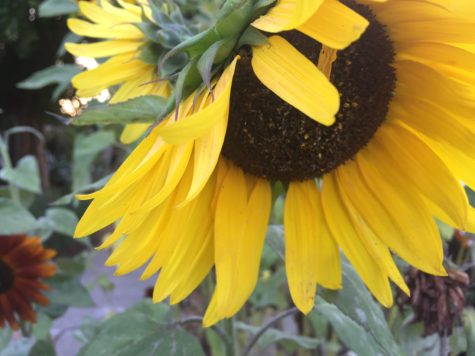 There’s an unclaimed patch of ground right next to our driveway, the planting strip between the sidewalk and the street. Over the years it’s been filled with many things. Weeds, mostly. Orange poppies. Maroon-colored amaranth that toss confetti seeds across the sidewalk. Weeds, again.
There’s an unclaimed patch of ground right next to our driveway, the planting strip between the sidewalk and the street. Over the years it’s been filled with many things. Weeds, mostly. Orange poppies. Maroon-colored amaranth that toss confetti seeds across the sidewalk. Weeds, again.
This year, my husband and our youngest son planted sunflowers in the dirt. It was April, and almost every morning, my son would go out to see if the sunflowers were there yet. And they were, slowly. First shoots and then toddler-knee high. Then grown-up knee high. Now, in August, I can barely reach the tallest of them. Almost all the stalks have flowers, and the bright yellow faces do something cheerful. People stop to look at them, they make our sometimes tattered house look charmingly tattered, as if it’s perhaps a tattered house in Provence.
As they grew over the course of the summer, the sunflowers had work to do: they followed the sun. In the morning, they faced east toward our neighbors’ houses and the mountains behind. At noon they faced down the street, out to the world. At dusk they turned toward the front door.
Now it’s just the small ones, the plants that have not yet bloomed, that lean in to the curve of the moving sun. The largest of them gaze with open faces at the neighbors’, at the mountains.
This is how it is with sunflowers—the young ones track the sun like a sentence they can’t stop reading. Last year, researchers reported that when they staked young sunflowers to prevent them from following their daily arc, the flowers grew more slowly. The movement allows the sunflowers to add cells on the side that is stretching during their sun salutation, growing on the east side during the day, the west side during the night.
But there’s benefit in staying still, too. The large sunflowers bask in the sun from the east, warming their surfaces and, the researchers write, attracting five times as many pollinators as sunflowers that faced west.
Some of the biggest sunflowers in our small patch have leaves that are starting to droop. Their days, like summer’s, are numbered. But in these last few weeks of summer, I want to do what sunflowers do—to follow the sun, to move, to grow. And then to stand, soaking it all in.
Then we’ll collect the seeds, and start again.